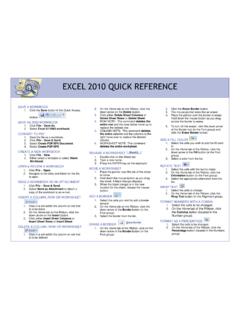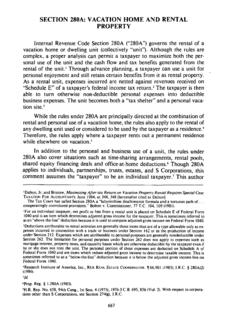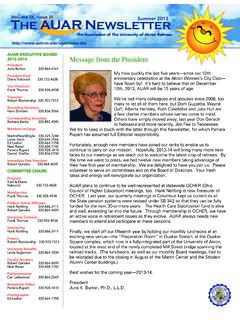Transcription of ARMY CORE LEADER COMPETENCIES - University of Akron
1 Section5 Leadership TrackKey Points1 Leading2 Developing3 AchievingARMY CORE LEADERCOMPETENCIESArmy leaders in this century need to be pentathletes,multi-skilled leaders who can thrive in uncertain andcomplex operating environments .. innovative andadaptive leaders who are expert in the art and scienceof the profession of Francis J. HarveySecretary of the ArmySpeech for US Army Command and General Staff College graduation (2005)e8420010_LT5_p054-069 8/26/08 11:25 AM Page 54 IntroductionLeaders provide purpose, direction, and motivation. Army leaders work hard to leadpeople, to develop themselves, their subordinates, and organizations, and toaccomplish their missions across the spectrum of continuously building and refining your values and attributes, as well asacquiring more professional knowledge, is only part of becoming a competent succeeds when you act and apply the core LEADER COMPETENCIES .
2 As youmove from direct leadership positions to the organizational and strategic LEADER levels,those COMPETENCIES will take on different nuances and Matthew B. Ridgway exemplified the qualities of a true Army LEADER in Success and Leadership ExcellenceGEN Matthew B. Ridgway successfully led the 82d Airborne Division and XVIIIA irborne Corps during World War II. He later commanded the Eighth ( ) Armyduring the Korean War. GEN Ridgway exemplified the qualities of the competentand multiskilled Army LEADER . His knowledge of American Soldiers, other services,allies, foreign cultures, and the overall strategic situation led him to expectations gave him a baseline from which to assess his commandonce he arrived in theater.
3 He continually visited units throughout the EighthArmy area, talked with Soldiers and their commanders, assessed commandclimate, and took action to mold attitudes with clear intent, supreme confidence,and unyielding tactical Ridgway constantly sought to develop and mentor subordinate com-manders and their staffs by sharing his thoughts and expectations of combat lead-ership. He frequently visited the frontlines to feel the pulse of the fighting forces,shared their hardships, and demanded they be taken care of. He took care of histroops by pushing the logistic systems to provide creature comforts as well as warsupplies. He eliminated the skepticism of purpose, gave Soldiers cause to fight,and helped them gain confidence by winning small victories.
4 GEN Ridgway led byexample. His actions during four months in command of the Eighth Army prior tohis appointment as United Nations Supreme Commander bring to life the LEADER scompetencies. He left a legacy that leaders can operate within the spheres of alllevels of leadership to accomplish their mission consistently and Core LEADER COMPETENCIES 558420010_LT5_p054-069 8/15/08 10:27 AM Page 55 Figure shows the Army Leadership Requirements Model. You will refer to this modela great deal during your ROTC studies. On the left are the attributes you ve been studyingin Sections 2 through 4 character, presence,and LEADER intelligenceor intellect. On theright are the core LEADER COMPETENCIES you ll read about in this section leading, developing,and leadingcategory includes four LEADER COMPETENCIES .
5 Two focus on who you are leadingand with what degree of authority and influence:leads othersand extends influence beyondthe chain of other COMPETENCIES address two ways by which you conveyinfluence:leads by exampleand othersinvolves influencing Soldiers or Army civilians in your unit or competency has a number of components, including setting clear direction,enforcing standards, and balancing the care of followers against mission influence beyond the chain of commandrequires the ability to operate in anenvironment, including both higher and lower command structures, and using yourinfluence outside the traditional chain of command. This includes connecting withjoint, allied, and multinational partners;local nationals; and civilian-led governmentalor nongovernmental agencies.
6 In this area, you must often operate without designatedauthority or while others do not recognize your by exampleis essential to leading effectively over the course of time. Whetheryou intend to or not, you provide an example that others consider and use in what56 SECTION 5 Figure Army Leadership Requirements Model8420010_LT5_p054-069 8/15/08 10:27 AM Page 56they do. This competency reminds you to serve as a role model. Your actions shouldbe grounded in the Army Values and imbued with the Warrior that you gain a clear understanding of what needs to be done,and why, within your organization. This competency deals with maintaining a clearfocus on the team s efforts to achieve goals and tasks to accomplish missions.
7 It helpsbuild consensus and is a critical tool for successful operations in diverse multinationalsettings. You refine your communicating abilities by developing advanced oral, written,and listening OthersAll the Army s core LEADER COMPETENCIES , especiallyleading others,involve influence. Youcan draw on a variety of techniques to influence others. These range from obtainingcomplianceto building a commitmentto achieve. Resistance is the opposite of complianceand commitment. There are many techniques for influencing others to comply or commit,and you can use one or more of them to fit to the specifics of any influence is based primarily on your authority. Giving a directorder to a follower is one approach to obtaining compliance during a task.
8 Compliance isappropriate for short-term, immediate requirements and for situations where little riskcan be tolerated. Compliance techniques are also appropriate for use with others who arerelatively unfamiliar with their tasks or unwilling or unable to commit fully to the something needs to be done with little time for delay, and there is no need for asubordinate to understand why the request is made, then compliance is an acceptableapproach. Compliance-focused influence is not particularly effective when your greatestaim is to create initiative and high esteem within your influence generally produces longer-lasting and broader compliance changes only a follower s behavior, commitment reaches deeper changing attitudes and beliefs, as well as behavior.
9 For example, when you buildresponsibility among followers, they will likely demonstrate more initiative, personalinvolvement, and creativity. Commitment grows from an individual s desire to gain a senseof control and develop self-worth by contributing to the organization. Depending on theobjective of the influence, leaders can strengthen commitment by reinforcing followers identification with the nation (loyalty), the Army (professionalism), the unit or organization(selfless service), the leadership in a unit (respect), and to the job (duty).Influence TechniquesYou can use several specific techniques for influence that fall along the continuum betweencompliance and commitment. The 10 techniques described below seek different degreesof compliance or commitment ranging from pressure at the compliance end to buildingrelations at the commitment end.
10 Yo uapply pressurewhen you use explicit demands to achieve compliance, such asestablishing deadlines for completing tasks, imposing negative consequences forfailure to complete. Indirect pressure includes persistent reminders of the requestand frequent checking . Legitimate requestsoccur when you refer to your source of authority to establishthe basis for a request. Exchangeis an influence technique that involves making an offer to provide somedesired item or action in trade for compliance with a request. The exchangetechnique requires you to control certain resources or rewards that those you areinfluencing Core LEADER COMPETENCIES 57compliancethe act of conforming toa specific requirement ordemandcommitmentwilling dedication orallegiance to a cause ororganization8420010_LT5_p054-069 8/15/08 10:27 AM Page 57 Personal appealsoccur when you ask the follower to comply with a request basedon friendship or loyalty.









